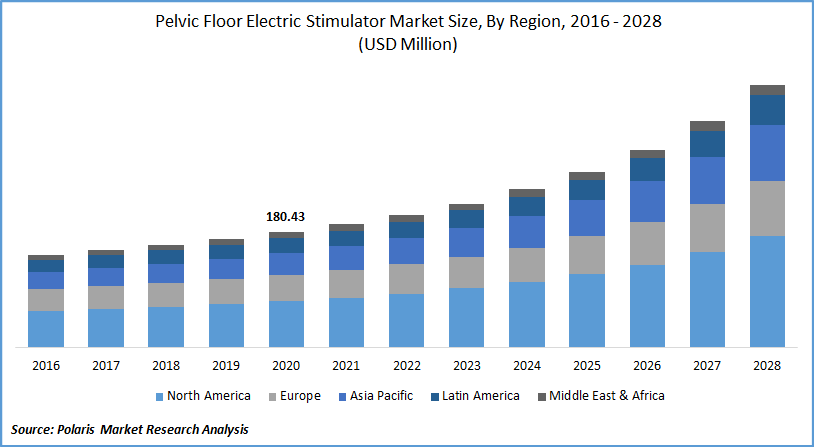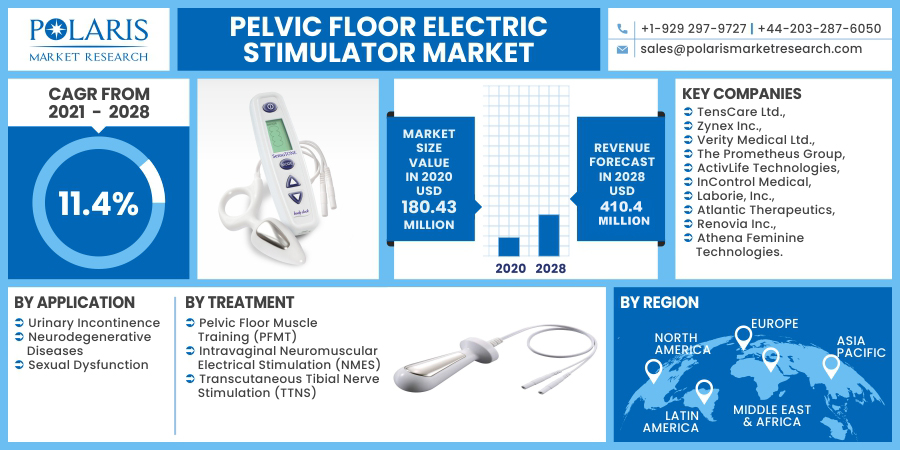
Pelvic Floor Electric Stimulator Market Share, Size, Trends, Industry Analysis Report
By Treatment; By Application (Urinary Incontinence, Neurodegenerative Diseases, Sexual Dysfunction); By Region; Segment Forecast, 2021 - 2028
- Published Date:Aug-2021
- Pages: 117
- Format: PDF
- Report ID: PM1945
- Base Year: 2020
- Historical Data: 2016-2019
Report Outlook
The global pelvic floor electric stimulator market was valued at USD 180.43 million in 2020 and is expected to grow at a CAGR of 11.4% during the forecast period. Advancement in technology and research and development activities have played a critical role in transforming the healthcare system over the last few decades. The increased public awareness and the introduction of high-speed internet service providers have led to the use of pelvic floor electric stimulator devices across the globe, particularly in regions where urinary incontinence is common.
 Know more about this report: request for sample pages
Know more about this report: request for sample pages
The demand for the pelvic floor electric stimulator market is growing due to the rising prevalence of chronic diseases. The market is benefiting from rising healthcare spending and infrastructure around the world. In addition, the growing consumer interest in the product increases the demand for pelvic floor electric stimulators.
Furthermore, a growing number of physiotherapists across the globe are promoting the use of these devices to help treat urinary incontinence, resulting in a rise in product sales. The demand for the devices is also expected to rise steadily as the U.S. FDA continues to approve a wide range of devices manufactured by various players in the existing market for pelvic floor electric stimulators.
Industry Dynamics
Growth Drivers
The market for pelvic floor electric stimulators is majorly driven by factors such as increasing recommendation of physiotherapists for the device usage, along with an increase in the geriatric population and people with chronic diseases (diabetes and hypertension), which is the root cause for many urological disorders. The advancement in technology is also expected to contribute to the growth of the market significantly.
There is an increase in senior citizens across the globe. In 2019, it was estimated there are more than 700 million aged 65 years or above in the world, and the number of aged persons is expected to touch 1.5 billion by 2050, which is double the number of older people living currently. Older people are more susceptible to urinary disorders for which pelvic floor electric stimulators are used. Nearly 50% of hospital visits by aged people are due to some urological complications.
An estimated 200 million people are suffering from urinary incontinence, and in the U.S. alone, nearly 29 million women are suffering from this condition. Another important factor contributing to the increase in urinary incontinence is the increasing number of people with diabetes and hypertension.
Over 420 million people have diabetes globally, and the numbers are expected to sharply rise to an estimated 700 million diabetic populations by 2045. Hypertension is more prevalent than diabetes, and it affects approximately 1.1 billion people around the world. The number of people with hypertension is expected to be 29% of the global population by 2025. All these factors are expected to boost the growth of the market during the forecast period.
The increase in demand for pelvic floor electric stimulators has resulted in the launch and approval of new devices in the market. For instance, in 2020, Atlantic Therapeutics received FDA approval to sell its Innovo system over the counter. The device is worn like a pair of shorts, and now it is prescribed by physiotherapists regularly, and it is more effective than pelvic floor exercises and other physical therapies.
According to the company, 3.5 million therapy sessions have been conducted using this system. In 2019, the company also raised USD 30.6 million in series B funding to commercialize the system.
COVID-19 pandemic is expected to have a negligible impact on the global industry for pelvic floor electric stimulators. Even though due to the pandemic, hospital visits across the globe are declined, but for non-emergency or non-critical conditions, online consultations are being conducted.
People suffering from urinary incontinence are attending online sessions with physiotherapists, and based on the prescriptions, people are buying electric stimulators. Since these devices are used at home even during the pandemic, the market for pelvic floor electric stimulators is expected to see an upward growth.

Know more about this report: request for sample pages
Pelvic Floor Electric Stimulator Market Report Scope
The market is primarily segmented on the basis of treatment, application, and region.
|
By Application |
By Treatment |
By Region |
|
|
|
Know more about this report: request for sample pages
Insight by Application
The urinary incontinence segment generated the highest revenue of the pelvic floor electric stimulator in 2020, owing to an increasing product launch by prominent market players and the growing prevalence of anxiety and urge incontinence. The elderly population and pregnant women are more vulnerable to urinary incontinence.
According to a study reported in the NCBI, the prevalence in pregnant women ranges from 32% to 64%. According to the Office on Women's Health (US Department of Health and Human Services), approximately 4 out of 10 pregnant women experience urinary incontinence. All these factors are expected to lead to the segment's expansion.
The sexual dysfunction segment is anticipated to grow at the highest rate during the forecast timeframe. The launch of products by the major market players increased information about the treatment of sexual dysfunction with a pelvic floor electric stimulator. The growing prevalence of sexual dysfunction is one factor that could drive market growth in the coming years.
Geographic Overview
North America pelvic floor electric stimulator market is expected to be the largest region for the global market during the forecast period due to the increased adoption and awareness about the devices and the massive number of people living from diabetes and hypertension. More than 34 million people in the U.S. have diabetes.
The Asia Pacific is expected to be the fastest-growing region for the global market for pelvic floor electric stimulators during the forecast period as physiotherapists are increasingly prescribing these devices to patients in this region. China and India have a massive population of diabetic and hypertension patients. More than a million in India have diabetes. In Japan, 28% of the population is above the age of 65. All these factors will propel the growth of the market in this region.
Competitive Insight
Major players in the market for pelvic floor electric stimulators are looking to launch new products because of increased regulatory approvals of electrical stimulator devices across the globe. Companies are looking to raise funds and enter into collaboration to develop and commercialize pelvic floor electric stimulators.
Some of the major players operating in the market for pelvic floor electric stimulators include TensCare Ltd., Zynex Inc., Verity Medical Ltd., The Prometheus Group, ActivLife Technologies, InControl Medical, Laborie, Inc., Atlantic Therapeutics, Renovia Inc., and Athena Feminine Technologies.
Report Scope
|
Report Attributes |
Details |
|
Market size value in 2020 |
USD 180.43 million |
|
Revenue forecast in 2028 |
USD 410.39 million |
|
CAGR |
11.4% from 2021 - 2028 |
|
Base year |
2020 |
|
Historical data |
2016 - 2019 |
|
Forecast period |
2021 - 2028 |
|
Quantitative units |
Revenue in USD million/billion and CAGR from 2021 to 2028 |
|
Segments covered |
By Application, By Treatment, By Region |
|
Regional scope |
North America Europe Asia Pacific Latin America; Middle East & Africa |
|
Key Companies |
TensCare Ltd., Zynex Inc., Verity Medical Ltd., The Prometheus Group, ActivLife Technologies, InControl Medical, Laborie, Inc., Atlantic Therapeutics, Renovia Inc., and Athena Feminine Technologies. |
